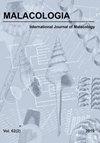华南入侵苹果螺抗寒性和干旱性的性别差异
IF 1
4区 生物学
Q4 ZOOLOGY
引用次数: 4
摘要
应激反应的性别差异可能是决定种群结构的一个关键因素。在出生时,小管Pomacea种群的性别比通常平均为1:1,但成年后往往偏向于雌性。低温和干旱是影响繁殖扩散和种群发展的主要非生物胁迫。因此,我们研究了Pomacea sp.(主要是panaliculata,也可能包括pmaculata)在抗寒性和耐干燥性方面是否存在性别差异。结果表明,在冷旱胁迫和越冬过程中,雌性的成活率高于雄性。在冷旱胁迫下,58%的雌性和40%的雄性在3°C的干旱条件下存活了6天。随着抗旱性的提高,Pomacea的束缚水、甘油和脂质含量增加,自由水分含量降低。除脂类外,其他生理参数均存在性别差异,且均表现出有利于雌螺在冷旱胁迫下存活的趋势。这些结果表明,在寒冷和干燥的条件下,雌性Pomacea的存活率可能高于雄性。本文章由计算机程序翻译,如有差异,请以英文原文为准。
Sex Differences in Cold Hardiness and Desiccation Tolerance of Invasive Apple Snails in South China
ABSTRACT Sex differences in stress responses may be a key factor that determines population structure. Sex ratios of Pomacea canaliculata populations usually average 1:1 at birth, but are often female-biased for adults. Low temperatures and drought are the main abiotic stresses affecting reproductive dispersal and population development. Therefore, we investigated whether Pomacea sp. (mainly P. canaliculata but might include P. maculata) exhibited sex differences in cold hardiness and desiccation tolerance. The results show that more females survived than males during cold-drought stress and overwintering. Following cold-drought stress, 58% of females and 40% of males survived at 3°C drought conditions for 6 days. With the development of cold-drought hardiness, increased amounts of bound water, glycerol and lipids were found in Pomacea sp. along with decreased free water levels. These physiological parameters exhibited sex differences in the snails, except for lipids, and the changes all showed tendencies favoring the survival of females under cold-drought stress. These results suggest that female Pomacea sp. may be more viable than males under cold and dry conditions.
求助全文
通过发布文献求助,成功后即可免费获取论文全文。
去求助
来源期刊

Malacologia
生物-动物学
CiteScore
2.00
自引率
0.00%
发文量
15
审稿时长
3 months
期刊介绍:
Malacologia publishes papers on all groups of the Mollusca. Malacologia specializes in publishing long papers and monographic treatments. Complete data are especially appreciated. Papers must be of interest to an international readership. Papers in systematics, ecology, population ecology, genetics, molecular genetics, evolution and phylogenetic treatments are especially welcomed. Also welcomed are letters to the editor involving papers published or issues of import to science of the day.
 求助内容:
求助内容: 应助结果提醒方式:
应助结果提醒方式:


